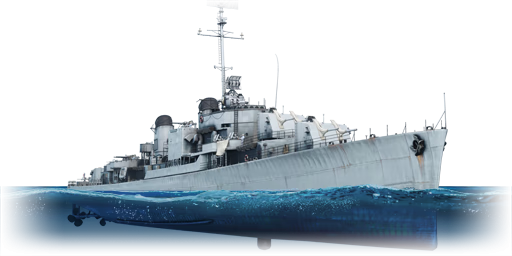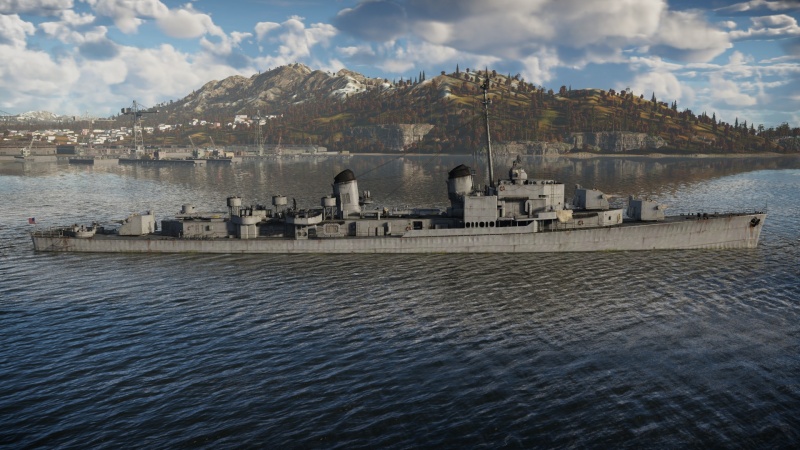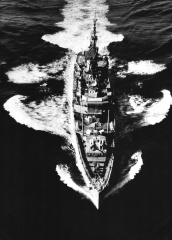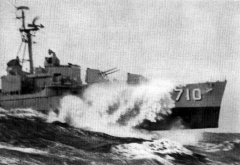USS Gearing
Contents
Description
The Gearing-class, USS Gearing (DD-710), 1945 is one of 98 Gearing-class destroyers built for the US Navy near the end of WW2. Laid down in mid 1944, she wouldn't be commissioned until the 3rd of May 1945; meaning she saw only roughly 3 months before the end of hostilities with the Japanese empire. She would go on to serve for nearly 3 decades more, mostly with the Atlantic fleet, notably taking part in the blockade of Cuba during the Cuban missile crisis, before finally being decommissioned in 1973.
Introduced in Update "Danger Zone", USS Gearing is one of the best destroyers in War Thunder. With 3x dual mount turrets, she has greater main battery firepower than the Fletcher class, though with one less dual mount than the Porter class. In exchange, she gains extra anti-fragmentation armour and, as she is in her 1945 refit, one of the greatest anti-aircraft batteries on any destroyer. This comes with the loss of one torpedo launcher compared to the USS Frank Knox, another ship of her class.
General info
Survivability and armour
USS Gearing, as a late war US destroyer, has very good armour in comparison to destroyers from other nations. This takes the shape of a main armour belt consisting of 0.75 inches of anti-fragmentation armour. While being unable to stop any fire from other destroyer or cruiser guns such as the commonly found 5-6 inch, it will still drastically reduce the damage done to the internals of the ship from high-explosive shells. This greatly increases the survivability of the ship, especially against Japanese ships such as the IJN Shimakaze which have no access to any form of SAP or AP. The top of the machinery spaces are covered by a layer of 0.5-inch armour as well, protecting against shrapnel from shells landing higher in the ship. This, in combination with the respectable crew of 336 members, gives her good survivability, some of the best of the USN destroyers, surpassed only by the USS Sumner and Mitscher-class destroyers.
The dual mounts, similar to other US destroyers, were designed as dual-purpose, and were therefore unable to be protected by thick armour as this would slow turret traverse. This means the turrets are only lightly covered by 0.125-inch anti-fragmentation armour. Any direct hit from anything larger than a 20 mm will almost definitely knock out the turret, although at least near misses will leave the turret unharmed or with only slight damage.
However, the USS Gearing still has one of the issues left over from earlier US destroyers: the rear magazine being elevated near the waterline. This was a necessity to allow room for the propeller shafts in the stern of the ship, but still can have rather explosive consequences. The issue has been alleviated somewhat compared to the earlier Porter-class which are infamous for how easily they are destroyed via this area, but captains should still be wary and avoid fire to the aft of the ship whenever possible.
Mobility
The mobility of the USS Gearing is typical of most American destroyers, meaning that it accelerates quickly, turns surprisingly well, and can switch to reverse in a short amount of time. The overall top speed is competitive at its BR, but will still be beaten by the likes of the Z25 or Soviet destroyers such as the Leningrad.
| Mobility Characteristics | |||||
|---|---|---|---|---|---|
| Game Mode | Upgrade Status | Maximum Speed (km/h) | Turn Time (s) | Turn Radius (m) | |
| Forward | Reverse | ||||
| AB | Stock | 57 | 23 | ~116.9 | ~206.72 |
| Upgraded | 78 | 31 | ___ | ___ | |
| RB/SB | |||||
| Upgraded | 64 | 25 | ___ | ___ | |
Modifications and economy
Armament
Primary armament
The 5-inch guns of the USS Gearing are the same as on other American destroyers, with their fast fire rate and access to both SAP shells and proximity-fused shells. Unlike the destroyers USS Somers or USS Porter, the USS Gearing only has 3 twin turrets instead of 4, thus resulting in 25% less main calibre firepower.
| Penetration statistics | |||||||
|---|---|---|---|---|---|---|---|
| Ammunition | Type of warhead |
Penetration @ 0° Angle of Attack (mm) | |||||
| 1,000 m | 2,500 m | 5,000 m | 7,500 m | 10,000 m | 15,000 m | ||
| AAC Mk.34 | HE | 36 | 36 | 36 | 36 | 36 | 36 |
| Common Mk.32 | Common | 124 | 103 | 77 | 58 | 46 | 37 |
| SP Common Mk.46 | SP Common | 150 | 125 | 93 | 71 | 56 | 45 |
| AAVT Mk.31 | HE-VT | 36 | 36 | 36 | 36 | 36 | 36 |
| Shell details | ||||||||||||
|---|---|---|---|---|---|---|---|---|---|---|---|---|
| Ammunition | Type of warhead |
Velocity (m/s) |
Projectile mass (kg) |
Fuse delay (s) |
Fuse sensitivity (mm) |
Explosive mass (TNT equivalent) (g) |
Ricochet | |||||
| 0% | 50% | 100% | ||||||||||
| AAC Mk.34 | HE | 792 | 25 | 0 | 0.1 | 3,220 | 79° | 80° | 81° | |||
| Common Mk.32 | Common | 792 | 24.49 | 0.01 | 6 | 1,150 | 47° | 60° | 65° | |||
| SP Common Mk.46 | SP Common | 792 | 25 | 0.01 | 6 | 906.5 | 48° | 63° | 71° | |||
| Proximity-fused shell details | ||||||||||||
|---|---|---|---|---|---|---|---|---|---|---|---|---|
| Ammunition | Type of warhead |
Velocity (m/s) |
Projectile mass (kg) |
Fuse delay (s) |
Fuse sensitivity (mm) |
Arming distance (m) |
Trigger radius (m) |
Explosive mass (TNT equivalent) (g) |
Ricochet | |||
| 0% | 50% | 100% | ||||||||||
| AAVT Mk.31 | HE-VT | 792 | 25 | 0 | 0.1 | 457 | 23 | 3,220 | 79° | 80° | 81° | |
Secondary armament
The USS Gearing has a very strong secondary armament, with a total of 16 x 40 mm Bofors cannons that can completely shred any aircraft at medium range and obliterate any small boat that would come too close. These cannons can also make quick work of exposed modules on destroyers at close range. Compared to other Gearing-class destroyers, USS Gearing is in her 1945 fit. As enemy air attack was more of a threat, one of the quintuple torpedo launchers was replaced with a quadruple 40 mm Bofors mount, giving her a much more substantial medium anti-aircraft battery, the most of any other American bluewater destroyer.
- Universal: AP-T · HEFI-T
- 40 mm HE clips: HEFI-T · HEFI-T · HEFI-T · AP-T
- 40 mm AP clips: AP-T · AP-T · AP-T · HEFI-T
| Penetration statistics | |||||||
|---|---|---|---|---|---|---|---|
| Ammunition | Penetration @ 0° Angle of Attack (mm) | ||||||
| 10 m | 100 m | 500 m | 1,000 m | 1,500 m | 2,000 m | ||
| HEFI-T | 3 | 3 | 3 | 3 | 3 | 3 | |
| AP-T | 81 | 78 | 68 | 58 | 49 | 41 | |
| Shell details | ||||||||||||
|---|---|---|---|---|---|---|---|---|---|---|---|---|
| Ammunition | Velocity (m/s) |
Projectile mass (kg) |
Fuse delay (m) |
Fuse sensitivity (mm) |
Explosive mass (TNT equivalent) (g) |
Ricochet | ||||||
| 0% | 50% | 100% | ||||||||||
| HEFI-T | 874 | 0.9 | 0 | 0.1 | 67.13 | 79° | 80° | 81° | ||||
| AP-T | 874 | 0.89 | - | - | - | 47° | 60° | 65° | ||||
Anti-aircraft armament
The short range AA of the USS Gearing is made up of no less than 11 x 20 mm Oerlikon autocannons. These can quickly handle most close range threats, but their range is limited, so if they start firing then look out for closing threats.
Additional armament
The USS Gearing is capable of carrying both 10 x 533 mm Mk.15 Torpedoes and 24 x Mk.6 depth charges. The torpedoes are effective at close range with a powerful warhead consisting of 224 kg of TNT, however their limited range of 5.50 km (9.15 km with Torpedo Mode) can limit their utility on larger maps prevalent at higher BRs.
The depth charges are dropped from the back of the ship and as such are only useful in the event of an opponent being directly behind the ship. This is a very rare event even at low BRs so carrying these exposed drums of TNT is not recommended.
Usage in battles
The USS Gearing can be played aggressively as the fast firing 5-inch guns and powerful 40 mm cannons can shred most opponents with ease and the large crew count allows for punishment to be taken in return. It is recommended to release torpedoes early in the match to prevent them from being detonated later in the match.
Pros and cons
Pros:
- Very powerful close and medium AA armament
- Large crew complement for a destroyer for longer survivability
- Fast firing 5-inch guns
- Good antifragmentation armour
Cons:
- Torpedoes have a relatively short range even with torpedo mode activated
- Only 6 main guns, compared to most American destroyers with 8
- Can be easily destroyed by an ammo rack detonation caused by SAP and APHE shots
History
Design and Construction
Design work of the Gearing class started with the preceding Sumner class, which were themselves a modified Fletcher incorporating the new twin high angle twin mounts for the 5"/38 calbre guns. The Gearing design mainly evolves from the Sumner by increasing the length of the hull by 4.3 metres, allowing greater fuel storage and therefore increased range. The higher beam to length ratio also increased the top speed, most of the ships in the class achieving 36 knots. USS Gearing herself was commissioned on May 3rd 1945.
FRAM I Upgrades
During the 1960s, USS Gearing received the Fleet Rehabilitation and Modernization (FRAM) 1 upgrades. This converted the Gearing from a primarily anti-aircraft destroyer into a dedicated anti-submarine warfare destroyer. Modifications include the new advanced sonar, the ASROC anti-submarine torpedo launcher (also capable of launching nuclear depth charges), the Mk.44 torpedo and the DASH anti-submarine helicopter which had a range of 35 km as well as the hangar and facilities needed to maintain it.
Service History
USS Gearing was commissioned a few months before the end of WW2 and trained crews for other destroyers until early October 1945. Her immediate postwar career was spent in peacetime operations on the Atlantic side of the Americas before sailing into the Mediterranean in 1947 until 1948. Gearing would then operate around the Caribbean before taking part in Operation Frostbite, sailing into the Arctic to test and develop cold water techniques and equipment before returning to operate in the Caribbean and Mediterranean until 1961 when she took part in the negotiations for the Santa Maria hijacking. In the following year, Gearing would take part in the blockade of Cuba before moving on to operate in the Atlantic when diplomatic negotiation ended the crisis. After receiving the FRAM I upgrades she would continue her normal operations.
USS Gearing would be decommissioned in 1973 and then sold for scrap the following year.
Media
- Skins
- Photos
- Videos
See also
- Other ships of similar configuration and role
External links
| Federal Shipbuilding and Drydock Company | |
|---|---|
| Gun Destroyers (DD) | |
| Somers-class | USS Somers |
| Fletcher-class | USS Fletcher |
| Allen M. Sumner-class | USS Sumner |
| Gearing-class | USS Gearing |
| Cruiser, Light (CL) | |
| Atlanta-class | USS Atlanta |
| USA destroyers | |
|---|---|
| Clemson-class | USS Welborn C. Wood · USS Barker · USS Litchfield |
| Farragut-class | USS Aylwin |
| Porter-class | USS Porter · USS Phelps · USS Moffett |
| Somers-class | USS Somers · USS Davis |
| Fletcher-class | USS Fletcher · USS Bennion · USS Cowell |
| Allen M. Sumner-class | USS Sumner |
| Gearing-class | USS Gearing · USS Frank Knox |
| Mitscher-class | USS Mitscher · USS Wilkinson |







